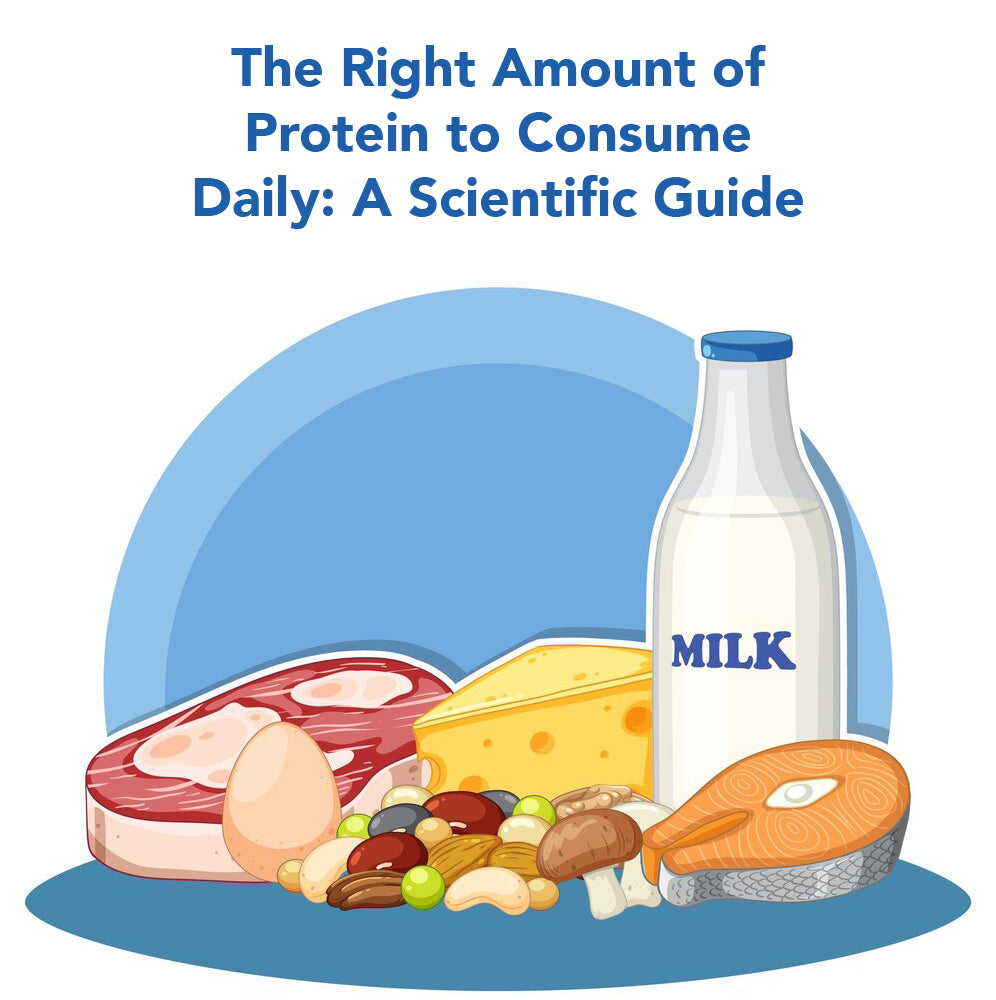Discover Related Products
Now explore supplements designed to support Longevity, Gut Health & Cellular Vitality.
CITOZYM - Support Natural Detox, Immune and Longevity Support
The Right Amount of Protein to Consume Daily: A Scientific Guide

Proteins are essential macronutrients for growth, maintenance, and repair of body tissues. They play a crucial role in enzyme and hormone synthesis. This article explores the recommended daily protein intake based on scientific evidence and how these recommendations vary depending on different factors.
Protein Requirements: General Guidelines
The recommended dietary allowance (RDA) for protein for an average adult is 0.8 grams per kilogram of body weight, according to the Food and Nutrition Board of the Institute of Medicine (1). This value is set to prevent protein deficiencies and maintain basic bodily functions in sedentary individuals.
To calculate your personal protein requirement, use this formula:
Protein requirement=Body weight in kg×0.8
Differences in Requirements Based on Age and Gender
Protein needs can vary based on age and gender. Men generally require more protein than women due to greater muscle mass. Additionally, during childhood and adolescence, protein needs are higher to support growth and development (4).
Protein Requirements for Athletes and Active Individuals
People who engage in regular physical activity, especially endurance or strength training, have higher protein needs. Protein intake for athletes is recommended to be between 1.2 and 2.0 grams per kilogram of body weight per day (2). This helps support muscle repair and growth and provides the necessary energy for intense workouts.
Proteins and Aging
As we age, our bodies become less efficient at using proteins. Sarcopenia, or muscle mass loss, is a common issue among the elderly. To combat this, older adults can benefit from higher protein intake, ranging from 1.2 to 1.5 grams per kilogram of body weight per day (3). Adequate protein intake can help maintain muscle mass, improve strength, and enhance overall quality of life.
Sources of Protein
Proteins can be obtained from both animal and plant sources. Animal sources, such as meat, fish, eggs, and dairy, are considered complete proteins as they contain all essential amino acids. Plant sources, such as legumes, grains, nuts, and seeds, can be combined to provide a complete amino acid profile.
Healthy and Potentially Harmful Proteins
Not all protein sources are equal in terms of health benefits. Here is an overview of healthy and potentially harmful proteins:
Healthy Proteins:
- Fish: Rich in omega-3 fatty acids, beneficial for heart health. For example, salmon and tuna are excellent sources of protein and healthy fats (6).
- Lean meats: Chicken, turkey, and lean cuts of beef are excellent sources of high-quality protein with less saturated fat compared to fatty meats.
- Legumes: Beans, lentils, and chickpeas are rich in protein and fiber, contributing to digestive health and weight control (7).
- Nuts and seeds: Almonds, chia seeds, and flaxseeds provide protein, healthy fats, and fiber, along with essential vitamins and minerals.
-
Low-fat dairy: Greek yogurt and skim milk are excellent sources of protein without excess saturated fat.
- Processed meats: Sausages, hot dogs, and bacon are often high in saturated fats, sodium, and preservatives like nitrites and nitrates, which have been linked to an increased risk of cardiovascular diseases and cancer (8).
- Low-quality protein powders: Some protein supplements may contain contaminants, additives, and artificial sweeteners that could have negative health effects if consumed in excess (9).
- Fatty meats: Cuts of meat high in saturated fats, such as fatty steaks, can increase the risk of heart disease if consumed frequently.
Effects of Excessive Protein Intake
While proteins are essential, excessive intake can pose health risks. Too much protein can strain the kidneys and increase the risk of kidney dysfunction, especially in individuals with pre-existing kidney issues (5). Additionally, excess protein can contribute to weight gain if total caloric intake exceeds the individual's energy needs.
Distribution of Protein Throughout the Day
In addition to the total amount of protein consumed, the distribution of protein across meals throughout the day is important. Studies have shown that a balanced distribution of protein across the three main meals can improve muscle protein synthesis and support the maintenance of lean mass (6). For example, dividing protein intake so that approximately 20-30 grams of protein are consumed at breakfast, lunch, and dinner may be more effective than concentrating protein intake in a single meal.
Interactions of Proteins with Other Nutrients
Proteins do not act in isolation in the body; they interact with other nutrients that can influence their digestion and utilization. For example, concurrent intake of carbohydrates and proteins can enhance muscle protein synthesis post- exercise due to insulin stimulation (7). Fats can also affect protein absorption, slowing digestion and the release of amino acids into the bloodstream, which can have beneficial effects on satiety.
Conclusions
Determining the right amount of protein to consume daily is crucial for supporting bodily functions, maintaining muscle mass, and promoting post- workout recovery. Recommendations vary based on individual factors such as age, gender, physical activity level, and overall health status. Following these guidelines can help make informed dietary choices and improve overall health.
References
1. Institute of Medicine. Dietary Reference Intakes for Energy, Carbohydrate, Fiber, Fat, Fatty Acids, Cholesterol, Protein, and Amino Acids (Macronutrients). National Academies Press, 2005.2. Phillips SM, Van Loon LJ. "Dietary protein for athletes: from requirements to optimum adaptation." Journal of Sports Sciences, 2011.
3. Bauer J, et al. "Evidence-based recommendations for optimal dietary
protein intake in older people: a position paper from the PROT-AGE Study Group." Journal of the American Medical Directors Association, 2013.
4. Rodriguez NR, et al. "Position of the American Dietetic Association, Dietitians of Canada, and the American College of Sports Medicine: Nutrition and Athletic Performance." Journal of the American Dietetic Association, 2009.
5. Martin WF, Armstrong LE, Rodriguez NR. "Dietary protein intake and renal function." Nutrition & Metabolism, 2005.
6. Mamerow MM, et al. "Dietary protein distribution positively influences 24-h muscle protein synthesis in healthy adults." Journal of Nutrition, 2014.
7. Tipton KD, Wolfe RR. "Protein and amino acids for athletes." Journal of Sports Sciences, 2004.
8. World Health Organization. "Q&A on the carcinogenicity of the consumption of red meat and processed meat." WHO, 2015.
9. National Institutes of Health. Dietary Supplements: What You Need to Know. NIH, 2020.







No comments